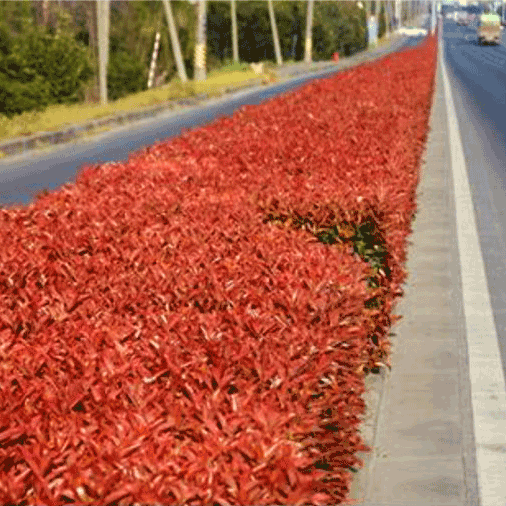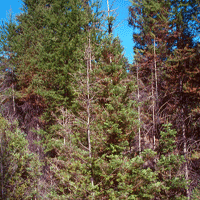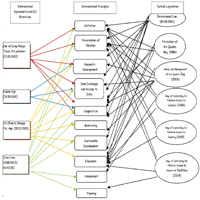In urban areas of China, several plant species are commonly used for ornamental purposes. Many of these plants have demonstrated a good capacity to resist these varied urban stresses, and it would be relevant to verify whether they can be grown on polluted sites and demonstrate some phytoremediation potential. Twelve ornamental shrub species were chosen to be tested for tolerance to inorganic contaminants and capacity to absorb and concentrate heavy metals in their aerial parts. A large split-plot trial comprising 20 plots was set up, and soil was spiked with different metals (Cu, Pb and Zn). In general, all twelve shrub species performed well regardless of the treatment. Two Hibiscus species, H. mutabilis and H. syriacus “Hamabo” were particularly productive. In terms of capacity to uptake metals, two of the best performing species were Spiraea japonica, for copper, and Nandina domestica, for lead. Bioconcentration and transfer factors were low. This could be related to weak development of the root systems in these recently established plants. Species with high yield, such as the two Hibiscus species, presented more interesting values in terms of quantity of metal extracted, and could eventually be recommended for decontamination of soils polluted by inorganics.
Keywords
, , , ,
Citation
Vincent G, Shang K, Zhang G, Labrecque M (2018). Preliminary results of the tolerance to inorganic contaminants and phytoextraction potential of twelve ornamental shrub species tested on an experimental contaminated site. iForest 11: 442-448. - doi: 10.3832/ifor2716-011
Academic Editor
Werther Guidi Nissim
Paper history
Received: Dec 22, 2017
Accepted: Apr 20, 2018
First online: Jun 18, 2018
Publication Date: Jun 30, 2018
Publication Time: 1.97 months
© SISEF - The Italian Society of Silviculture and Forest Ecology 2018
Open Access
This article is distributed under the terms of the Creative Commons Attribution-Non Commercial 4.0 International (https://creativecommons.org/licenses/by-nc/4.0/), which permits unrestricted use, distribution, and reproduction in any medium, provided you give appropriate credit to the original author(s) and the source, provide a link to the Creative Commons license, and indicate if changes were made.

Breakdown by View Type
(Waiting for server response...)
Article Usage
Total Article Views: 46014
(from publication date up to now)
Breakdown by View Type
HTML Page Views: 39224
Abstract Page Views: 2698
PDF Downloads: 3135
Citation/Reference Downloads: 6
XML Downloads: 951
Web Metrics
Days since publication: 2734
Overall contacts: 46014
Avg. contacts per week: 117.81
Article Citations
Article citations are based on data periodically collected from the Clarivate Web of Science web site
(last update: Mar 2025)
Total number of cites (since 2018): 6
Average cites per year: 0.75
Publication Metrics
by Dimensions ©
Articles citing this article
List of the papers citing this article based on CrossRef Cited-by.
(1)
Ali H, Khan E, Sajad MA (2013)Phytoremediation of heavy metals - concepts and applications. Chemosphere 91 (7): 869-881.
CrossRef |
Gscholar
(2)
Alloway BJ (2013)Heavy metals in soils: trace metals and metalloids in soils and their bioavailability. In: “Environmental pollution (3
rd edn)”. Springer, Netherlands, pp. 613.
Gscholar
(3)
Bada BS, Raji KA (2010)Phytoremediation potential of kenaf (
Hibiscus cannabinus L.) grown in different soil textures and cadmium concentrations. African Journal of Environmental Science and Technology 4 (5): 250-255.
Online |
Gscholar
(4)
Baker AJM, Reeves RD, Hajar ASM (1994)Heavy metal accumulation and tolerance in British populations of the metallophyte
Thlaspi caerulescens J. and C. Presl (Brassicaceae). New Phytologist 127: 61-68.
CrossRef |
Gscholar
(5)
Bissonnette L, St-Arnaud M, Labrecque M (2010)Phytoextraction of heavy metals by two Salicaceae clones in symbiosis with arbuscular mycorrhizal fungi during the second year of a field trial. Plant and Soil 332 (1-2): 55-67.
CrossRef |
Gscholar
(6)
Branigan T (2014)Chinese premier declares war on pollution in economic overall. The Guardian, 6
th March, 2014.
Online |
Gscholar
(7)
Courchesne F, Turmel MC, Cloutier-Hurteau B, Constantineau S, Munro L, Labrecque M (2017)Phytoextraction of soil trace elements by willow during a phytoremediation trial in southern Québec, Canada. International Journal of Phytoremediation 19 (6): 545-554.
CrossRef |
Gscholar
(8)
Dos Santos Utmazian MN, Wenzel WW (2007)Cadmium and zinc accumulation in willow and poplar species grown on polluted soils. Journal of Plant Nutrition and Soil Science 170 (2): 265-272.
CrossRef |
Gscholar
(9)
Dos Santos Utmazian MN, Wieshammer G, Vega R, Wenzel WW (2007)Hydroponic screening for metal resistance and accumulation of cadmium and zinc in twenty clones of willows and poplars. Environmental Pollution 148 (1): 155-165.
CrossRef |
Gscholar
(10)
French CJ, Dickinson NM, Putwain PD (2006)Woody biomass phytoremediation of contaminated brownfield land. Environmental Pollution 141: 387-395.
CrossRef |
Gscholar
(11)
Garbisu C, Alkorta I (2001)Phytoextraction: a cost-effective plant-based technology for the removal of metals from the environment. Bioresource Technology 77 (3): 229-236.
CrossRef |
Gscholar
(12)
Givens RL (2015)A botanical survey of native and non-native species along the Three Rivers Greenway in Columbia, South Carolina. Master’s thesis, University of South Carolina, SC, USA, pp. 24.
Online |
Gscholar
(13)
Guidi Nissim W, Palm E, Mancuso S, Azzarello E (2018)Trace element phytoextraction from contaminated soil: a case study under Mediterranean climate. Environmental Science and Pollution Research 25 (9): 9114-9131.
CrossRef |
Gscholar
(14)
Han D, Currell, MJ, Cao G (2016)Deep challenges for China’s war on water pollution. Environmental Pollution 218: 1222-1233.
CrossRef |
Gscholar
(15)
Han SH, Kim DH, Shin SJ (2013)Bioaccumulation and physiological response of five willows to toxic levels of cadmium and zinc. Soil and Sediment Contamination 22 (3): 241-255.
CrossRef |
Gscholar
(16)
Ho WM, Ang LH, Lee DK (2008)Assessment of Pb uptake, translocation and immobilization in kenaf (
Hibiscus cannabinus L.) for phytoremediation of sand tailings. Journal of Environmental Sciences 20 (11): 1341-1347.
CrossRef |
Gscholar
(17)
Jaillard B, Plassard C, Hinsinger P (2003)Measurements of H
+ fluxes and concentrations in the rhizosphere. In: “Handbook of Soil Acidity” (Rengel Z ed). CRC Press, Boca Raton, FL, USA, pp. 231-266.
Online |
Gscholar
(18)
Kacálková L, Tlustos P, Száková J (2014)Chromium, nickel, cadmium, and lead accumulation in maize, sunflower, willow, and poplar. Polish Journal of Environmental Studies 23 (3): 753-761.
Online |
Gscholar
(19)
Kidd P, Mench M, Alvarez-López V (2015)Agronomic practices for improving gentle remediation of trace element-contaminated soils. International Journal of Phytoremediation 17 (11): 1005-1037.
CrossRef |
Gscholar
(20)
Kou S, Vincent G, Gonzalez E, Pitre FE, Labrecque M, Brereton NJB (2018)The response of a 16S ribosomal RNA gene fragment amplified community to lead, zinc and copper pollution in a Shanghai field trial. Frontiers in Microbiology 9: 496.
CrossRef |
Gscholar
(21)
Kuppusamy S, Palanisami T, Megharaj M, Venkateswarlu K, Naidu R (2016)In-situ remediation approaches for the management of contaminated sites: a comprehensive overview. Reviews of Environmental Contamination and Toxicology 236: 1-115.
CrossRef |
Gscholar
(22)
Lasat MM (2000)Phytoextraction of metals from contaminated soil: a review of plant/soil/ metal interaction and assessment of pertinent agronomic issues. Journal of Hazardous Substance Research 2 (5): 1-25.
Gscholar
(23)
Liang J, Fang HL, Zhang TL, Wang XX, Liu YD (2017)Heavy metal in leaves of twelve plant species from seven different areas in Shanghai, China. Urban forestry and Forest Greening 27: 390-398.
CrossRef |
Gscholar
(24)
Lim JM, Salido AL, Butcher DJ (2004)Phytoremediation of lead using Indian mustard (
Brassica juncea) with EDTA and electrodics. Microchemical Journal 76 (1): 3-9.
CrossRef |
Gscholar
(25)
Mench M, Vangronsveld J, Didier V, Clijsters H (1994)Evaluation of metal mobility, plant availability and immobilization by chemical agents in a limed-silty soil. Environmental Pollution 86 (3): 279-286.
CrossRef |
Gscholar
(26)
Mench M, Schwitzguébel JP, Schroeder P, Bert V, Gawronski S, Gupta S (2009)Assessment of successful experiments and limitations of phytotechnologies: contaminant uptake, detoxification and sequestration, and consequences for food safety. Environmental Science and Pollution Research 16 (7): 876-900.
CrossRef |
Gscholar
(27)
Nouri J, Khorasani N, Lorestani B, Karami M, Hassani AH, Yousef N (2009)Accumulation of heavy metals in soil and uptake by plant species with phytoremediation potential. Environmental Earth Sciences 59 (2): 315-323.
CrossRef |
Gscholar
(28)
Ogunleye JA, Dagari MS, Balogun OL, Maigari A (2016)Effect of oxalic acid on Cr
3+ ion uptake, accumulation and oxidative stress by Sorrel (
Hibiscus sabdariffa L.) seedlings in hydroponic solution. International Journal of Chemical, Material and Environmental Research 3 (3): 49-55.
Online |
Gscholar
(29)
Poschenrieder C, Bech J, Llugany M, Pace A, Fenés E, Barceló J (2001)Copper in plant species in a copper gradient in Catalonia (North East Spain) and their potential for phytoremediation. Plant and Soil 230 (2): 247-256.
CrossRef |
Gscholar
(30)
Reeves RD, Baker A (2000)Metal-accumulating plants. In: “Phytoremediation of toxic metals” (Raskin I, Ensley BD eds). Wiley, New York, USA, pp. 304.
Gscholar
(31)
Sheng X, Xia JJ, Jiang CY, He LY, Qian M (2008)Characterization of heavy metal-resistant endophytic bacteria from rape (
Brassica napus) roots and their potential in promoting the growth and lead accumulation of rape. Environmental Pollution 156 (3): 1164-1170.
CrossRef |
Gscholar
(32)
Shi G, Chen Z, Xu S, Zhang J, Wang L, Bi C, Teng J (2008)Potentially toxic metal contamination of urban soils and roadside dust in Shanghai, China. Environmental Pollution 156: 251-260.
CrossRef |
Gscholar
(33)
Tian ZH, Song K, Da LJ (2015)Distribution patterns and traits of weed communities along an urban-rural gradient under rapid urbanization in Shanghai, China. Weed Biology and Management 15: 27-41.
CrossRef |
Gscholar
(34)
Walter R, Keller C, Boschi K (2003)Phytoextraction capacity of trees growing on a metal contaminated soil. Plant Soil 256: 265-272.
CrossRef |
Gscholar
(35)
Wei BG, Yang LS (2010)A review of heavy metal contaminations in urban soils, urban road dusts and agricultural soils from China. Microchemical Journal 92: 99-107.
CrossRef |
Gscholar
(36)
Wu HB, Fang HL, Peng HL, Liang J, Hu YH, Cai YP, Hao GJ (2012)Soil physical properties analysis of the typical newly established green belt of Shanghai Chenshan Botanical Garden. Journal of Soil and Water Conservation 26 (6): 85-90.
Gscholar
(37)
Yanqun Z, Yanqun Z, Yuan L, Schwartz C, Langlade L, Fan L (2004)Accumulation of Pb, Cd, Cu and Zn in plants and hyperaccumulator choice in Lanping lead-zinc mine area, China. Environment International 30 (4): 567-576.
CrossRef |
Gscholar
(38)
Zhuang P, Yang QW, Wang HB, Shu WS (2007)Phytoextraction of heavy metals by eight plant species in the field. Water, Air, and Soil Pollution 184 (1-4): 235-242.
CrossRef |
Gscholar


















